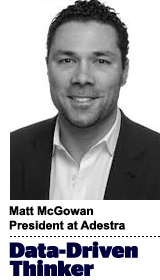 “Data-Driven Thinking” is written by members of the media community and contains fresh ideas on the digital revolution in media.
“Data-Driven Thinking” is written by members of the media community and contains fresh ideas on the digital revolution in media.
Today’s column is written by Matt McGowan, president at Adestra.
The publishing industry has long been in a state of flux, most recently with the transition from print to digital.
Now, with Facebook changing its news feed to emphasize posts from friends and family, rather than those from media and brands, publishers face a new challenge to the world to which they most recently adapted.
Facebook’s changing algorithms will force publishers to adjust how they manage their online spaces.
It likely will end – or at least reduce the effectiveness of – the common tactic of throwing every article up on the publisher’s Facebook wall to see what sticks. Publishers will now have to put up content that produces conversation without using gimmicks to inflate clicks and comments.
Facebook is changing its news feed to keep it relevant and useful for users and forcing publishers into helping achieve that.
Some publishers might think they can just keep on as they have been but will realize too late – once they discover they’ve fallen off the radars of their customers and fans – that they needed to change tactics. If they regularly spend some of their acquisition budget to pick up Facebook fans, that money will vanish along with their posts.
Is this the end of Facebook for publishers? Not necessarily. But publishers must become more strategic about how they use Facebook if they want to keep getting value from the channel.
They must choose quality content over quantity of content.
The should have community managers and social media teams study user data to see what their page followers have clicked and commented on and what gets conversations started on their pages.
They must also post content that connects with users and sparks engagement.
This change doesn’t portend the death of publishing on Facebook. If anything, it represents the maturation of a channel and industry that has aggressively changed itself many times over the past four years, faster than any other publishing vertical.
The Good Coming From The Change
This move will force publishers to think more closely about what connects them to the people who, at one time, clicked “like” on their pages. Instead of putting up content that offers two seconds of news as their users scroll through their feeds, publishers will start putting up content more likely to elicit clicks, comments and conversations.
It might also impel social media teams to explore the options Facebook already offers to boost visibility. Facebook allows users to customize their news feeds by clicking “See First” on the news feed tab of a page they follow. That option will not go away.
Cross-Pollinate With Other Channels To Maintain Engagement
Email marketers talk about channel propensity. Just because you have an email address doesn’t mean email is always the best place to try to engage with consumers. No, go where customers converge.
The same is true of social media marketing. The coming changes to Facebook’s news feed will require publishers to cross-pollinate their Facebook followers in other channels where content distribution is more complementary to their publishing goals.
Publishers should also promote other channels for other uses. They should no longer use Facebook as a place to distribute content and let their followers know where else they can connect with the publisher for more up-to-date content or how they can adjust preferences to see their page first.
Finally, publishers must respect the channel, whether it’s email, social or RSS. Publishers must think about what their readers want to see and what gets them to act. Don’t switch users to other channels and then blast them to pieces.
Follow Adestra (@Adestra) and AdExchanger (@adexchanger) on Twitter.
This post was syndicated from Ad Exchanger.

More Stories
Revolving Door Roundup: Gary Tuchman Departs CNN After 35 Years
The Winners and Losers of Google’s Big Cookie Reversal
Pew Survey Shows Education Level and Party Affiliation Tied to Views on Freedom of the Press